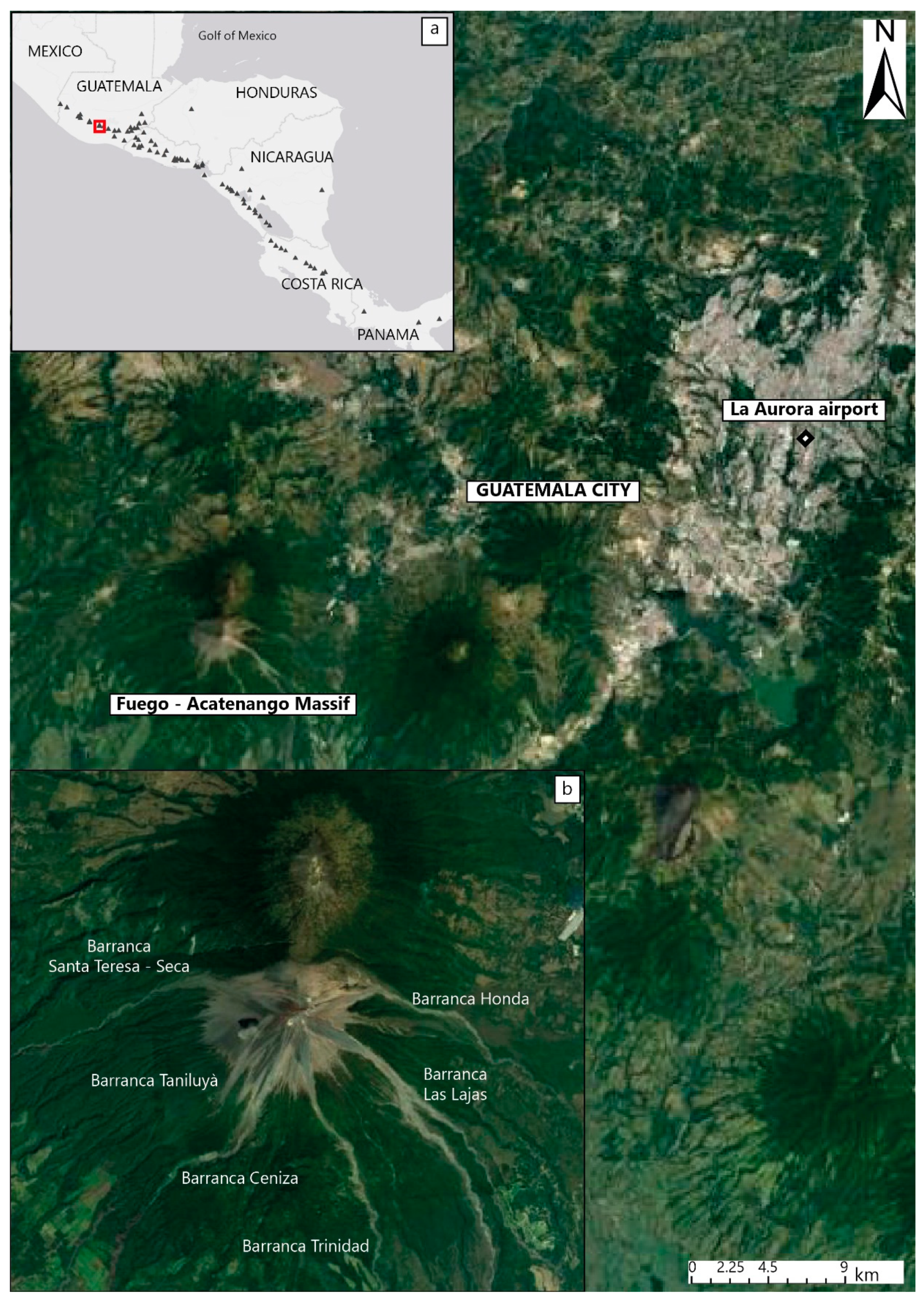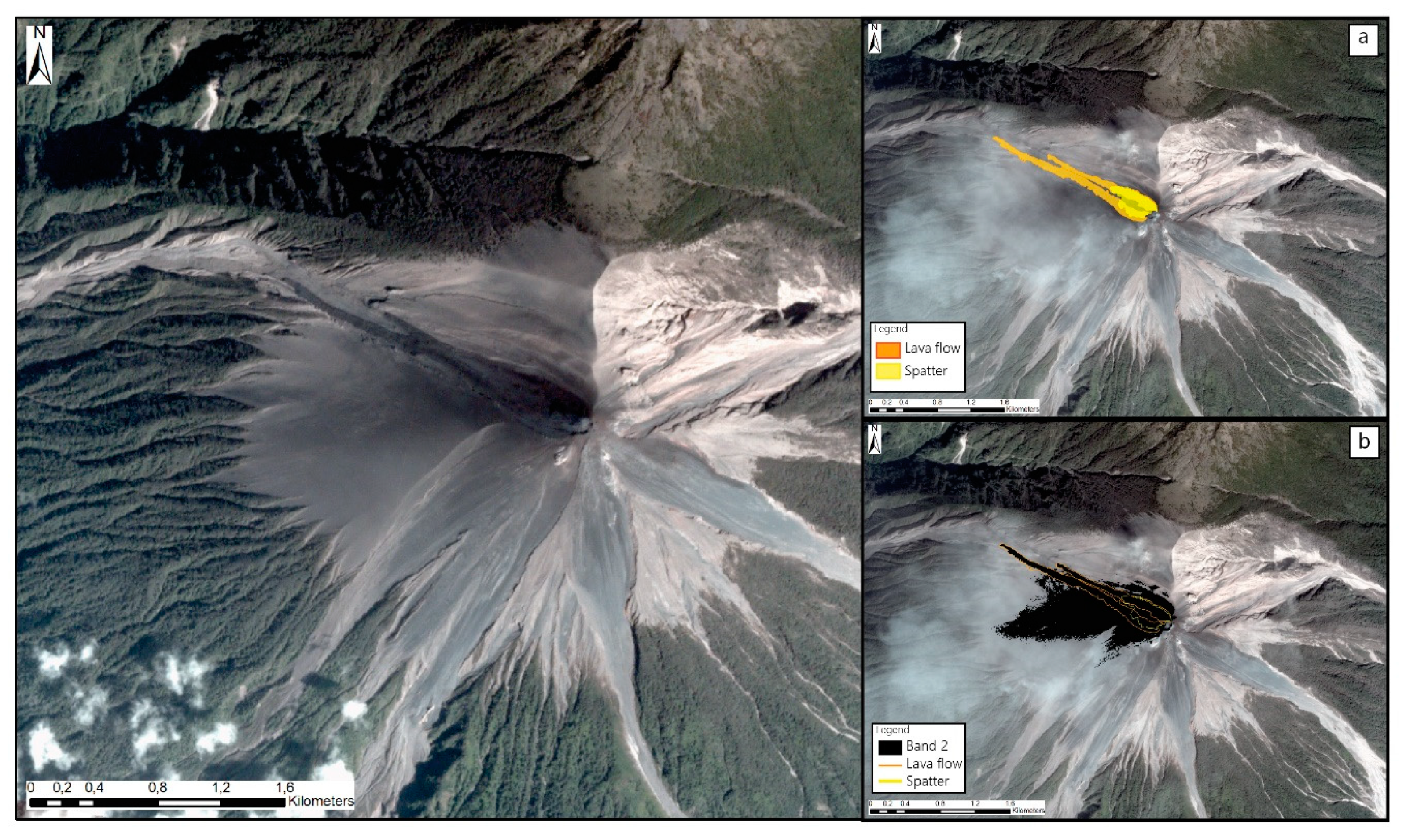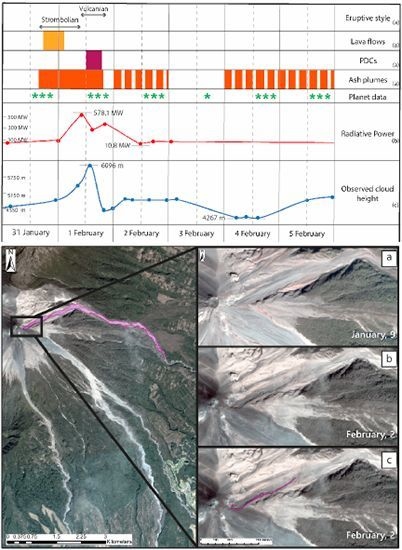Volcano Monitoring from Space Using High-Cadence Planet CubeSat Images Applied to Fuego Volcano, Guatemala
Abstract
:1. Introduction
2. Background
3. Data and Methods
3.1. The Planet Labs CubeSat Constellation
3.2. Data Processing
4. Results
4.1. Lava Flows
4.2. Tephra fall
4.3. Pyroclastic Density Currents
4.4. Structures Near the Vent and the Upper Cone Area
5. Discussion
6. Conclusions
Supplementary Materials
Author Contributions
Funding
Acknowledgments
Conflicts of Interest
References
- Dean, K.; Dehn, J.; McNutt, S.; Neal, C.; Moore, R.; Schneider, D. Satellite imagery proves essential for monitoring erupting Aleutian Volcano. Eos. Trans. Am. Geophys. Union. 2002, 83, 241–247. [Google Scholar] [CrossRef]
- Pieri, D.; Abrams, M. ASTER watches the world’s volcanoes: A new paradigm for volcanological observations from orbit. J. Volcanol. Geotherm. Res. 2004, 135, 13–28. [Google Scholar] [CrossRef]
- Ramsey, M.; Dehn, J. Spaceborne observations of the 2000 Bezymianny, Kamchatka eruption: the integration of high-resolution ASTER data into near real-time monitoring using AVHRR. J. Volcanol. Geotherm. Res. 2004, 135, 127–146. [Google Scholar] [CrossRef]
- Thomas, H.E.; Watson, I.M. Observations of volcanic emissions from space: Current and future perspectives. Nat. Hazards. 2010, 54, 323–354. [Google Scholar] [CrossRef]
- Herold, M.; Scepan, J.; Clark, K.C. The use of remote sensing and landscape metrics to describe structures and changes in urban land uses. Environ. Plan. Econ. Space. 2002, 34, 1443–1458. [Google Scholar] [CrossRef]
- Carn, S.A.; Krueger, A.J.; Krotkov, N.A.; Yang, K.; Evans, K. Tracking volcanic sulfur dioxide clouds for aviation hazard mitigation. Nat. Hazards. 2008, 51, 325–343. [Google Scholar] [CrossRef]
- Campion, R.; Martinez-Cruz, M.; Lecocq, T.; Caudron, C.; Pacheco, J.; Pinardi, G.; Hermans, C.; Carn, S.; Bernard, A. Space-and ground-based measurements of sulphur dioxide emissions from Turrialba Volcano (Costa Rica). Bull. Volcanol. 2012, 74, 1757–1770. [Google Scholar] [CrossRef]
- Carn, S.A.; Clarisse, L.; Prata, A.J. Multi-decadal satellite measurements of global volcanic degassing. J. Volcanol. Geotherm. Res. 2016, 311, 99–134. [Google Scholar] [CrossRef]
- Carter, A.J.; Ramsey, M.S.; Belousov, A.B. Detection of a new summit crater on Bezymianny Volcano lava dome: Satellite and field-based thermal data. Bull. Volcanol. 2007, 69, 811–815. [Google Scholar] [CrossRef]
- Vaughan, R.G.; Keszthelyi, L.P.; Lowenstern, J.B.; Jaworowski, C.; Heasler, H. Use of ASTER and MODIS thermal infrared data to quantify heat flow and hydrothermal change at Yellowstone National Park. J. Volcanol. Geotherm. Res. 2012, 233–234, 72–89. [Google Scholar] [CrossRef]
- Wessels, R.L.; Vaughan, R.G.; Patrick, M.R.; Coombs, M.L. High-resolution satellite and airborne thermal infrared imaging of precursory unrest and 2009 eruption at Redoubt Volcano, Alaska. J. Volcanol. Geotherm. Res. 2013, 259, 248–269. [Google Scholar] [CrossRef]
- Wright, R.; Blackett, M.; Hill-Butler, C. Some observations regarding the thermal flux from Earth’s erupting volcanoes for the period of 2000 to 2014. Geophys. Res. Lett. 2015, 42, 282–289. [Google Scholar] [CrossRef]
- Norini, G.; Groppelli, G.; Sulpizio, R.; Carrasco-Núñez, G.; Dávila-Harris, P.; Pellicioli, C.; Zucca, F.; De Franco, R. Structural analysis and thermal remote sensing of the Los Humeros Volcanic complex: Implications for volcano structure and geothermal exploration. J. Volcanol. Geotherm. Res. 2015, 301, 221–237. [Google Scholar] [CrossRef]
- Flynn, L.P.; Harris, A.J.L.; Wright, R. Improved identification of volcanic features using Landsat 7 ETM+. Remote Sens. Environ. 2001, 78, 180–193. [Google Scholar] [CrossRef]
- Lu, D.; Li, G.; Valladares, G.S.; Batistella, M. Mapping soil erosion risk in Rondônia, Brazilian Amazonia: Using RUSLE, remote sensing and GIS. Land Degrad. Dev. 2004, 15, 499–512. [Google Scholar] [CrossRef]
- Carter, A.J.; Ramsey, M.S. ASTER- and field-based observations at Bezymianny Volcano: Focus on the 11 May 2007 pyroclastic flow deposit. Remote Sens. Environ. 2009, 113, 2142–2151. [Google Scholar] [CrossRef]
- Lanari, R.; Lundgren, P.; Sansosti, E. Dynamic deformation of Etna Volcano observed by satellite radar interferometry. Geophys. Res. Lett. 1998, 25, 1541–1544. [Google Scholar] [CrossRef] [Green Version]
- Hooper, A.; Zebker, H.; Segall, P.; Kampes, B. A new method for measuring deformation on volcanoes and other natural terrains using InSAR persistent scatterers. Geophys. Res. Lett. 2004, 31, 23. [Google Scholar] [CrossRef]
- Ramsey, M.S.; Fink, J.H. Estimating silicic lava vesicularity with thermal remote sensing: A new technique for volcanic mapping and monitoring. Bull. Volcanol. 1999, 61, 32–39. [Google Scholar] [CrossRef]
- Kervyn, M.; Ernst, G.G.J.; Goossens, R.; Jacobs, P. Mapping volcano topography with remote sensing: ASTER vs. SRTM. Int. J. Remote Sens. 2008, 29, 6515–6538. [Google Scholar] [CrossRef]
- Joyce, K.E.; Belliss, S.E.; Samsonov, S.V.; McNeill, S.J.; Glassey, P.J. A review of the status of satellite remote sensing and image processing techniques for mapping natural hazards and disasters. Prog. Phys. Geogr. Earth Environ. 2009, 33, 183–207. [Google Scholar] [CrossRef] [Green Version]
- Arnous, M.O.; Green, D.R. GIS and remote sensing as tools for conducting geo-hazards risk assessment along Gulf of Aqaba coastal zone, Egypt. J. Coast. Conserv. 2011, 15, 457–475. [Google Scholar] [CrossRef]
- Pallister, J.S.; Schneider, D.J.; Griswold, J.P.; Keeler, R.H.; Burton, W.C.; Noyles, C.; Newhall, C.G.; Ratdomopurbo, A. Merapi 2010 eruption—Chronology and extrusion rates monitored with satellite radar and used in eruption forecasting. J. Volcanol. Geotherm. Res. 2013, 261, 144–152. [Google Scholar] [CrossRef]
- Smithsonian Institution, Recent bulletin report. Bulletin of the Global Volcanism Program. Available online: https://volcano.si.edu/volcano.cfm?vn=342090 (accessed on 9 September 2019).
- Zhu, Z. Change detection using landsat time series: A review of frequencies, preprocessing, algorithms, and applications. ISPRS J. Photogramm. Remote Sens. 2017, 130, 370–384. [Google Scholar] [CrossRef]
- Planet Team, Planet Application Program Interface: In Space for Life on Earth. San Francisco, CA. 2017. Available online: https://api.planet.com. (accessed on 9 September 2019).
- Tucker, C.J.; Pinzon, J.E.; Brown, M.E.; Slayback, D.A.; Pak, E.W.; Mahoney, R.; Vermote, E.F.; El Saleous, N. An extended AVHRR 8-km NDVI dataset compatible with MODIS and SPOT vegetation NDVI data. Int. J. Remote Sens. 2005, 26, 4485–4498. [Google Scholar] [CrossRef]
- Grainger, R.G.; Peters, D.M.; Thomas, G.E.; Smith, A.J.A.; Siddans, R.; Carboni, E.; Dudhia, A. Measuring volcanic plume and ash properties from space. Geol. Soc. Lond. Spec. Publ. 2013, 380, 293–320. [Google Scholar] [CrossRef] [Green Version]
- Chesner, C.A.; Rose, W.I., Jr. Geochemistry and evolution of the fuego volcanic complex, Guatemala. J. Volcanol. Geotherm. Res. 1984, 21, 25–44. [Google Scholar] [CrossRef]
- Manea, V.C.; Manea, M.; Ferrari, L. A geodynamical perspective on the subduction of Cocos and Rivera plates beneath Mexico and Central America. Tectonophysics 2013, 609, 56–81. [Google Scholar] [CrossRef]
- Martin, D.P.; Rose, W.I., Jr. Behavioral patterns at Fuego volcano, Guatemala. J. Volcanol. Geotherm. Res. 1981, 10, 67–81. [Google Scholar] [CrossRef]
- Davies, D.K.; Quearry, M.W.; Bonis, S.B. Glowing avalanches from the 1974 eruption of the volcano Fuego, Guatemala. Geol. Soc. Am. Bull. 1978, 89, 369–384. [Google Scholar] [CrossRef]
- Lyons, J.J.; Waite, G.P.; Rose, W.I.; Chigna, G. Patterns in open vent, Strombolian behavior at Fuego volcano, Guatemala, 2005–2007. Bull. Volcanol. 2009, 72, 1–15. [Google Scholar] [CrossRef]
- Waite, G.P.; Nadeau, P.A.; Lyons, J.J. Variability in eruption style and associated very long period events at Fuego volcano, Guatemala. J. Geophys. Res. Solid Earth. 2013, 118, 1526–1533. [Google Scholar] [CrossRef]
- Kuenzi, W.D.; Horst, O.H.; McGehee, R.V. Effect of volcanic activity on fluvial-deltaic sedimentation in a modern arc-trench gap, southwestern Guatemala. Geol. Soc. Am. Bull. 1979, 90, 827–838. [Google Scholar] [CrossRef]
- MODVOLC, near-real-time satellite monitoring of global volcanism using MODIS. Available online: http://modis.higp.hawaii.edu/ (accessed on 9 September 2019).
- NOAA Satellites and Information Service, Current Volcanic Ash Advisories. Available online: https://www.ssd.noaa.gov/VAAC/messages.html (accessed on 9 September 2019).
- Richardson, A.J.; Wiegand, C.L. Distinguishing vegetation from soil background information. Photogramm. Eng. Remote Sens. 1977, 43, 1541–1552. [Google Scholar]
- Bannari, A.; Morin, D.; Bonn, F.; Heute, A.R. A review of vegetation indices. Remote Sens. Rev. 1995, 13, 95–120. [Google Scholar] [CrossRef]
- Loughlin, S.C.; Sparks, R.S.J.; Sparks, S.; Brown, S.K.; Jenkins, S.F.; Vye-Brown, C. Global Volcanic Hazard and Risk; Cambridge University Press: Cambridge, UK, 2015; pp. 1–80. [Google Scholar]










| Criteria | Planet Labs | Sentinel 2 | Landsat 8 | MODIS | ASTER | VIIRS | Digital Globe |
|---|---|---|---|---|---|---|---|
| Bands (wave length) | 4–5 (440–900 nm) | 13 (497–2190 nm) | 8 (0.45–12.5 µm) | 36 (0.405–14.385 µm) | 14 (0.52–11.62 µm) | 22 (0.412–12.01 µm) | 4–16 (450–2373 nm) |
| Night-time imagery | No | No | Yes | Yes | Yes | No | No |
| TIR/SWIR | No | Yes | Yes | Yes | Yes | Yes | Yes |
| Spatial resolution | 0.8–5 m | 10–60 m | 15–30 m | 250–1000 m | 15–90 m | 500–1000 m | 0.5–1.85 m |
| Cadence | <1–72 h | 5–10 d | 16 d | 6–12 h | Highly variable (days to weeks) | 24 h | Highly variable (days to months) |
| Product level | 1B | 1C | 2 | 1A–B | 1C | 1 | / |
| Criteria | PlanetScope (PS2) | |
|---|---|---|
| Deployment | ISS orbit | SSO orbit |
| Orbit altitude | 400 km | 475 km |
| Max/min latitude coverage | 52° | 81.5° |
| HFOV | 21.8 km | 24.6 km |
| VFOV | 14.5 km | 16.4 km |
| Area | 316 km2 | 405 km2 |
| Max image strip per orbit | 8100 km2 | 20,000 km2 |
| Analytic resolution | 16 bit | 16 bit |
© 2019 by the authors. Licensee MDPI, Basel, Switzerland. This article is an open access article distributed under the terms and conditions of the Creative Commons Attribution (CC BY) license (http://creativecommons.org/licenses/by/4.0/).
Share and Cite
Aldeghi, A.; Carn, S.; Escobar-Wolf, R.; Groppelli, G. Volcano Monitoring from Space Using High-Cadence Planet CubeSat Images Applied to Fuego Volcano, Guatemala. Remote Sens. 2019, 11, 2151. https://doi.org/10.3390/rs11182151
Aldeghi A, Carn S, Escobar-Wolf R, Groppelli G. Volcano Monitoring from Space Using High-Cadence Planet CubeSat Images Applied to Fuego Volcano, Guatemala. Remote Sensing. 2019; 11(18):2151. https://doi.org/10.3390/rs11182151
Chicago/Turabian StyleAldeghi, Anna, Simon Carn, Rudiger Escobar-Wolf, and Gianluca Groppelli. 2019. "Volcano Monitoring from Space Using High-Cadence Planet CubeSat Images Applied to Fuego Volcano, Guatemala" Remote Sensing 11, no. 18: 2151. https://doi.org/10.3390/rs11182151
APA StyleAldeghi, A., Carn, S., Escobar-Wolf, R., & Groppelli, G. (2019). Volcano Monitoring from Space Using High-Cadence Planet CubeSat Images Applied to Fuego Volcano, Guatemala. Remote Sensing, 11(18), 2151. https://doi.org/10.3390/rs11182151







